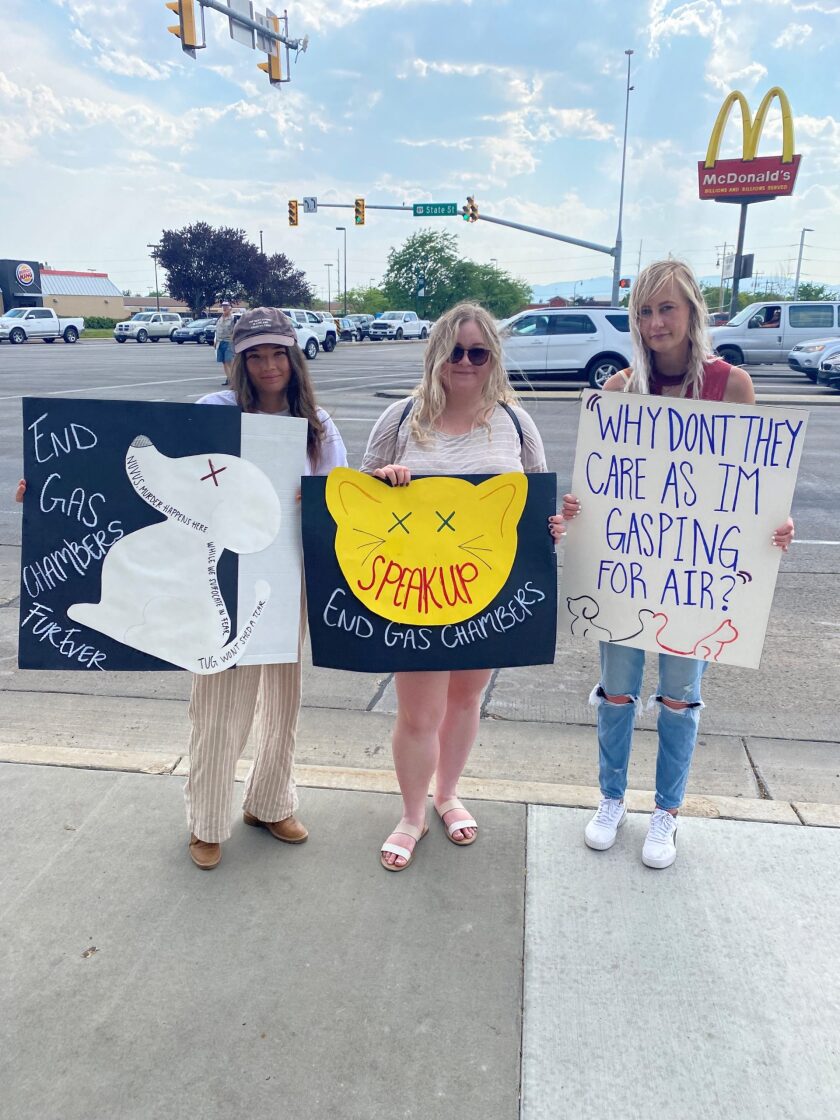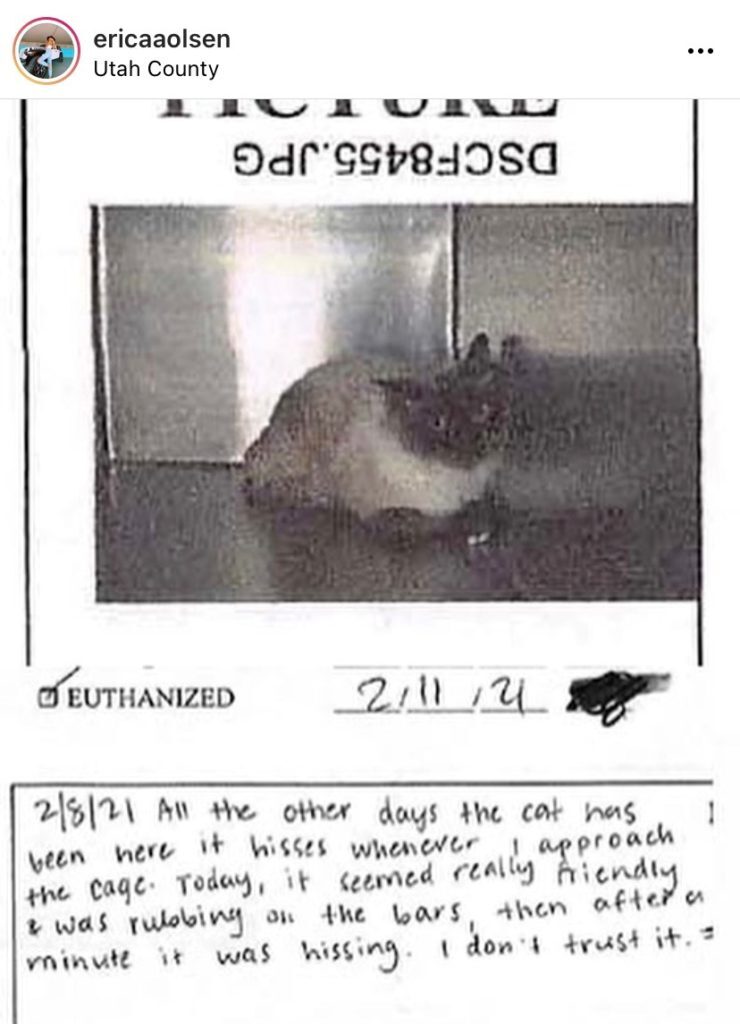
Utah animal rights advocates protested animal shelter gas chamber use on June 15 at Orem City Hall and presented a 50-foot-long petition to city council members.
The Utah Animal Rights Coalition organized the protest aftera petition to ban gas chambers at North Utah Valley Animal Shelter took off,
Protestors stood at the corner ofEast Center Street and South State Streetbearing signs that read, 'Our Pets Deserve Better Than a Cruel Gas Chamber Death' and 'Orem: Ban Gas Chamber Killing at Animal Shelter.'
Advocates plan to continue showing up at meetings and pressing the issue.
Human cost

Julie Davey is a former North Utah Valley Animal Shelter employee who shared her experience having to put animals in the gas chamber.
She said the shelter presented the gas chamber as humane and made it seem like the people protesting it don't know any better.
'Gas is not humane. I can't briefly or even verbally respond what it was like,' she said. 'Those dogs screamed. Cats would bounce across the cabinet doors like popcorn trying to get out and it was often very overcrowded so we were dropping cats in on top of other cats.'
This is not only an animal rights issue, but a human rights issue as well, she said. 'It's had a huge, huge human cost on my life.'
One time shelter workers had to put a sick litter of kittens in the gas chamber, she said. After the process was done, there was one kitten still alive underneath the mother and other kitten's corpses and they had to put her through again.
'It was completely traumatic and I will never be okay for the rest of my life because of what's happening at NUVAS.'
Unrolling the petition
The group went into the Orem City Council meeting at 6 p.m. to give personal statements after the protest. Utah Animal Rights Coalition (UARC) Director Jeremy Beckham and Erica Olsen, a member who started the petition, unrolled it front of the City Council. It had more than 13,000 signatures from Utah residents, not including tens of thousands of signatures from outside the state.
There wasn't enough room to completely unroll it as it stretched to both sides of the room. 'We just wanted to try to find a way to visualize this amount of public opposition,' Beckham told the City Council.
After unrolling the petition, Olsen spoke to the Council. 'These changes truly begin with you,' she said, asking them to put banning gas chambers in Utah at the top of their priorities.
She's a mother of two cats and can't have her own kids. 'These are our family members,' she said.
Davey also shared her experiences working at the shelter in a statement at the City Council meeting. 'I need you to understand that it is not humane,' she told the City Council. 'It is a very cruel method, and those animals suffer.'

Olsen said she felt there was a great turnout and she is going to keep the petition open to gain as many more signatures as possible.
'We're so thrilled, we're so excited,' she said. 'The support was phenomenal.'
Seeing all the signatures printed out really puts into perspective just how many there are, she added.
Opposing views
North Utah Valley Animal Shelter Director Tug Gettling spoke at theCity Council meeting
Gettling previously did not respond to multiple requests from The Daily Universe for an interview. His statements are from the June 15 City Council meeting, and Beckham's comments are from an interview at the protest following the meeting.
Reasons for euthanasia
Gettling said there are two reasons the shelter euthanizes animals. One is to end the suffering of an animal that cannot be served by medical intervention. The second reason is if the animals are deemed too aggressive to be put back into the community.

Beckham said this isn't true, as the Utah Animal Rights Coalition hasrecords
Gettling told the City Council that euthanizing animals is the 'least desirable' of what the shelter does. Nobody there wants to euthanize animals, and the staff of 12 people has an affinity toward them.
The number of animals euthanized each year varies, Gettling said, but the shelter has euthanized 86 animals from January to the present. The number depends on the volume of animals that come in.
Injection versus carbon monoxide
'We euthanize using carbon monoxide. And carbon monoxide has been shown to be an effective way to euthanize animals,' Gettling said.
The shelter chose the method because they believe it's the safest for the workers and less stressful for them, and also the most humane method for the animal, he continued. Carbon monoxide produces hypoxemia, a decrease in oxygen in the blood. The animals simply go unconscious and then 'expire' seconds later according to Gettling.
He mentioned the three distinct advantages of carbon monoxide as listed by theAmerican Veterinary Medical Association guidelines for euthanasia
Theguidelines
'He grossly misrepresented what the AVMA guidelines say,' Beckham said, adding that the guidelines are pretty clear that the preferred method of euthanasia for shelter animals is injection.
Gettling said injection is actually more stressful to the animal and they have to be handled differently, adding that there is less animal restraint and handling required when using gas chambers.
Dogs may 'vocalize' on occasion while in the gas chamber, Gettling said. The area of the brain affected by the hypoxemia causes the noise, rather than it being an indication of stress.
Gettling said the average time it takes for the animals to be unconscious is 83 seconds and then 172 seconds for them to expire. 'Our cycle only runs 15 minutes and 28 seconds.'
'If you were to ask these animal rights people if they've seen it or performed it, I haven't heard one that's said they've witnessed it. So where they get their information I don't know...'
He said maybe the advocates are getting their information from euthanasia in the 'old days' when animals were euthanized through car exhaust.
North Utah Valley Animal Shelter study
The shelter began a study looking at the advantages and disadvantages of both injections and carbon monoxide according to Gettling. They hope to have it done by the end of July.
The North Utah Valley Animal Services Administrative Control Board will then decide if the shelter should continue using the gas chambers or switch to injections, he said.
What's next?
Gettling believes legislative bills aimed at banning gas chamber use keep failing because legislators see 'the wisdom in allowing us to have as many humane choices as possible.'
There's a pattern across the United States of animal rights advocates protesting gas chambers and using their methods to 'intimidate, coerce and misinform,' Gettling said. Then decision makers do away with it because the pressure is too great.
'We don't believe we should be bullied into something because they disagree with it,' Gettling said, adding that the shelter should look at what the science says and other considerations.
'It's a fight we don't want. We don't hate them. We don't go after them. We simply try to do what's best for the animals and the citizens,' Gettling said.
